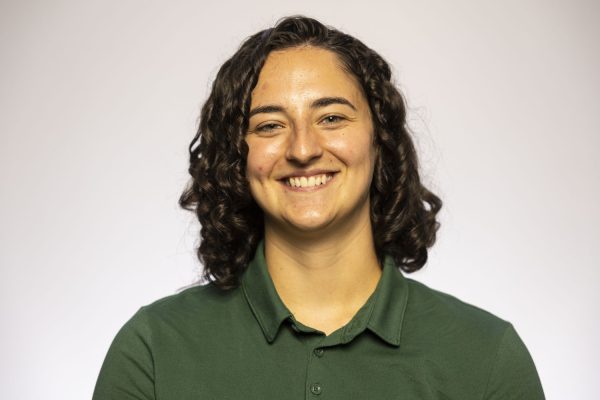UI research couple join new study on herbicide effects during pregnancy
After meeting in college, Donna and Mark Santillan bonded over their shared research interests and went on to become married research partners at the UI.
Farming machinery stands tall next to crop fields on the Meade Family Farm in Tiffin on Tuesday, June 28, 2016. In light of a recent EPA investigation, information has emerged linking the use of atrazine, a common herbicide sprayed across Iowa farm land, with negative health and environmental outcomes.
April 11, 2023
Donna and Mark Santillan met in English class on their first day of college at Loyola University and became inseparable college sweethearts and lab partners. From there, they married, became research partners, and have spent almost 20 years researching women’s health and pregnancy at the University of Iowa.
During graduate school, Donna Santillan was researching leukemia, but Mark Santillan said he takes credit for getting her interested in women’s health research, which is something he has always had an interest in.
“When we were married, I would leave all my medical journals everywhere and not pick it up, and I think she was just forced to read them all because I left them everywhere,” Mark Santillan said. “And so, as she picked up on it too, we would have these random questions over dinner because we’re nerds.”
The Santillans said their individual strengths and weaknesses complement each other well and have made them a great research team at the university.
For example, in a college lab, Donna Santillan had to act as Mark Santillan’s eyes during an experiment that required them to monitor a color change in a substance. The only issue with this lab was that Mark Santillan’s color blindness prevented him from seeing the color change.
“I can’t see pink at all, and so I kept on going, ‘Hey, is it pink yet?’” Mark Santillan said. “I ironically got a better grade in that lab than she did even though she effectively was my eyes.”
The Santillans ended up at the UI for research after Mark Santillan matched for his fellowship in Iowa City. A fellowship is financial support a university grants to fund a graduate student’s research pursuits.
Donna Santillan said she planned to conduct research wherever Mark Santillan ended up matching, so she interviewed for several research positions at the UI. Donna Santillan said she interviewed for different postdoctoral degree positions and labs.
“When Mark matched here, I followed up on those, and one happened to be in the department of OB-GYN. That was the lab I preferred, so that’s how we ended up in the same department,” Donna Santillan said.
RELATED: New UI training grant focuses on climate change impacts on health
The specific areas of research the Santillans have worked on at the UI include high blood pressure and other placenta-related diseases during pregnancy. The most recent study the Santillans have been involved in is in collaboration with the Heartland Health and Research Alliance.
This study is ongoing and researches the potential effects herbicides could have on a woman and her pregnancy, as this information is mostly unknown.
The Santillans’ involvement in this study will include giving samples like urine and cheek swab samples to other researchers involved in the study. The researchers can then compare the sample results to birth outcomes and draw conclusions.
UI Civil and Environmental Engineering professor David Cwiertny collaborates with the Santillans and was the person who originally connected them to the researchers of the study.
Cwiertny said this collaboration was ideal because they helped develop the UI’s Women’s Health Tissue Repository, which stores samples that can be used to study things related to women’s health.
“We like them because they’ve got access to samples, and we’ve got access to methods, so it’s a real natural partnership,” Cwiertny said.
Aside from their ability to provide research samples, Cwiertny said the Santillans also possess other qualities that make them exceptional researchers.
“From a very practical standpoint, they have this resource that is there that can be used in studies … That’s really valuable because it’s hard to get access to samples and have those connections,” Cwiertny said. “But I think, more importantly, they’ve got a really great collaborative spirit. They realize their resource, and they have a genuine care for the people they work with.”















